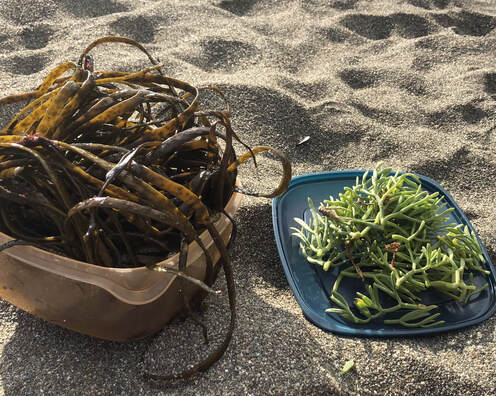|
This month I was lucky enough to fit a lovely weekend in away to visit some friends and family in Cornwall and obviously had to make the most of these late autumnal days still warm with sunshine with a trip to the beach. I thought I would also try my hand at foraging seaweed- a completely new area for me but I was keen to see what I could find. I have to say this was without very much research compounded by a fairly late night prior and therefore not surprisingly wielded fairly mixed results. There are quite a few edible species that can be found on British beaches and luckily no poisonous ones so although I am fairly inexperienced in this area I was at least not likely to poison myself. Same rules apply to seaside foraging as are common in the countryside- don't take more than you need, don't strip an area and maybe take a class before with an experienced forager if you want to be sure what your looking for. With a quick glance over a few guardian articles and blogs- the three types I set out looking for are thongweed (aka sea spaghetti), kelp and rock samphire. THONgWEEDApparently when young this grass like seaweed can be used like spaghetti- it is easily dried, stores well and apparently makes a great gluten free alternative. It is rich in calcium, zinc, magnesium, iodine and also contains the vitamins A, E, C, B1, B2, B7 and B9. The internet is full of delicious and creative recipes utilising and praising this seaweed so I was really excited to try and find some. Thongweed is attached to rocks with a kind of sucker and when this is removed the plant can not reproduce so it is important not to remove the whole plant. Apparently not a lot else looks similar so I'm still guessing these long tentacles pictured are indeed Thongweed aka Sea Spagehetti Unfortunately when I got home- the thongweed and its long tentacles started to creep me out and I really couldn't bring myself to cook it and instead had boring old wheat spaghetti for dinner. It did a few interesting things like becoming a beautiful and slightly more appetising shade of green when rinsed with hot water. It also gave off quite a lot of slimey mucus. I'd read in a newsletter from lovely greens that seaweed slimey water can be used to make a lye solution for cold process soaps. I already use a dried organic kelp for my seaweed and sage soap so thought this might be interesting to try instead. When its ready I'll be sure to update here. Unfortunately for me on this occasion Thongweed aka Sea Spaghetti wasn't the one and most of my tub has been put into the compost. I feel good at least the garden will benefit from all those added minerals and vitamins and I also feel good that I didn't make myself eat a bowl of slimy seaweed on this occasion. It did feel like a meal better suited for slugs and snails than tired holidaying megs. However I am excited to see how the soap turns out using the slimey seaweed water and do hope that I'll get to try some delicious recipes utilising thongweed in the future (just perhaps not foraged or cooked by me until further learning has been undertaken on the subject) SEA KelpPerhaps the seaweed I am most familiar with and already use in my favourite soap- Seaweed and Sage. For this soap I use a dried organic powder that is mixed with some oil and added at trace to the soap batter. Kelp has many varieties and most can be used in soap making and spa treatments- for more information in this area I would recommend checking out fellow bristol based beauty biz Seatox who specialise in amazing seaweed spa treatments. I'm not 100 per cent sure that I found any kelp and Im also not 100 per cent sure what I would have done with it anyway. It can be added to soups as well as soaps as an enhancer but I was definetly more after a bag of chips by this point and only collected some for the garden. Rock SamphireAnd last but not least I found something I can eat :) This was growing over lots of rocks and I collected enough for two delicious dinners. Ive actually picked and eaten this before a few years ago on holiday in france and totally forgot how great it is. Seeing how much was spread over the rocks I will be sure to cooking some up again next time I get the chance. I just lightly steamed the rock samphire and had with some other steamed green veggies. It tasted kind of a bit lemoney and a bit salty. Most likely at this time of year the plant would not be at its prime ( you can see a few dried and yellowing stalks) and further research has told me that July and August are the best times of year for this plant.
0 Comments
Leave a Reply. |
MEGSoap maker and DIY enthusiast- sharing some easy home makes. Archives
September 2022
|










 RSS Feed
RSS Feed
